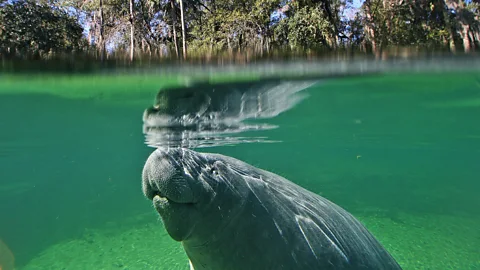An unprecedented 1,000 manatees are gathering in Florida this week – but why?
 Getty Images
Getty ImagesA record number of manatees converged at a Florida state park this week. Experts weigh in on this "very unusual" phenomenon.
Manatees are typically solitary animals, but this week they've gathered in record-breaking numbers at a Florida state park.
Nearly 1,000 of the gentle sea mammals, also known as sea cows, were counted at Blue Spring State Park earlier this week, as first reported via the park’s Facebook page. That's a jump from the last record gathering on New Year's Day 2024 when park rangers observed 736 of the beloved animals in the same space.
"This is very unusual," says Cora Berchem, a research associate at the non-profit Save the Manatee Club. "I was definitely expecting to see a high number, but not so many, so quickly."
Researchers from Save the Manatee Club, an organisation that works to protect manatees, have been documenting the lives of the animals since 2010. The club records the births, deaths, and relationships of the manatees, which has meant over the years it has compiled one of the world's longest running manatee databases.
The sheer number of manatees currently gathered together is notable, says Berchem, and while the reason for their arrival is uncertain, it may be weather related. The water in the nearby St Johns River, where the manatees are known to spend their time, recently dropped to a chilly 14.1C (58F). On that same day – easily the coldest of the year, says Berchem – a drove of manatees made a beeline for Blue Spring State Park, where the hot springs are typically a balmy 25C (72F) all year long.
"When the temperature is 14C (57F), that's really too cold for manatees, so they come into the spring to stay warm," continues Berchem. "They cannot tolerate prolonged cold weather."
 Save the Manatee Club
Save the Manatee ClubWhile the chubby round bodies of manatees may appear well-insulated, looks can be deceiving. Most manatees only have about one inch of body fat, and are extremely sensitive to chilly temperatures.
"The last couple of weeks we've had really strong cold fronts, one after another," says Monica Ross, director of manatee research and conservation for the Clearwater Marine Aquarium. "Anything below 20C (68F) and a manatee will have to thermoregulate or they start losing heat. And below 16C (60F) they get cold stress syndrome – their extremities do not get blood flow and they could lose skin or portions of their extremities, such as a portion of their tail, from cold stress."
In addition to the drop in temperatures, multiple algae blooms on Florida's east coast have killed off large swathes of seagrass, the manatees' main food source. Toxic "red tide" algae blooms have also claimed the lives of a number of manatees on Florida's coastline.
Ross says both the drop in temperature and algae may be driving the increased numbers of manatees in locations throughout central Florida.
And there's yet another possible reason why manatees are gathering at Blue Spring State Park: the location is a rare protected sanctuary for the animals, who are at risk of injury or death from collisions with watercraft. During the winter months (November through March) the park prohibits recreations such as canoeing, kayaking, paddle boarding and swimming.
The park provides protection from human activity so that the animals can safely rest and truly conserve all their energy.
Perhaps the most compelling theory for this unprecedented gathering? "I think the manatees know they are safe at Blue Spring State Park through their experiences there," says Ross.
